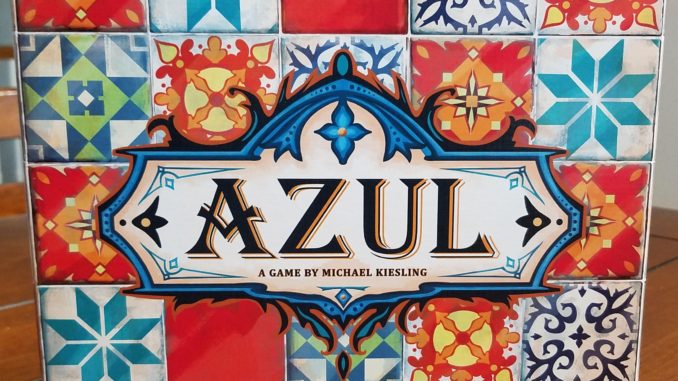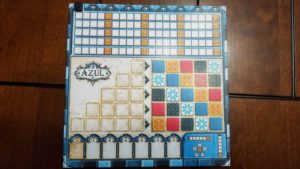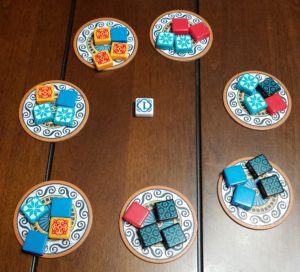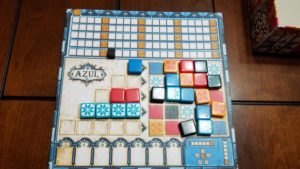
Azul was a game my wife came across somewhere and put it on her Christmas list last year.
Production- A
The game boards are made from a sturdy, heavy cardboard. They don’t feel like they’ll break or bend without focused effort to do so. The game tiles are all solid plastic but heavy enough not to slide around at the slightest gesture. This helps keep them in place on your board. The tiles are brightly colored and match the designs on the gameboard with ease. You can tell at a glance what pieces you want because in addition to the design they are also each a unique base color.
The tiles come in a big cloth bag which is perfect for digging around in to draw random tiles. I’ve seen some games where the draw bag is just big enough to hold the times but not big enough to really randomize them.
Theme- C
I’m not really sure what the theme of the game is. Maybe you’re building a quilt or rug or something similar? Maybe there isn’t a theme other than game play. I wouldn’t really call this a negative though because while’s not clear, it affects nothing.
Gameplay- A
 Prepare for high analysis paralysis with this one.
Prepare for high analysis paralysis with this one.
You start the game with an empty game board with a 5×5 grid of colored squares. In order to fill in the grid you need to acquire matching tiles of a fixed number. The top row requires one matching tile. The bottom needs five. The game is played in a series of rounds where players pick up tiles from a set of circles, each starting with four tiles. When all those tiles are gone, players score their board. Play continues until one player has a completed row and then bonus points are scored. High scpore wins.
The basic idea of the game is simple enough to get. Pick up tiles, fill rows. The details are where the strategy lies. When you pick up tiles, you must pick up all the matching tiles from that circle. If there are three, but you only want one, you have to place the extra two in a special row that gives you negative points. This is a point we missed on our first play through. You can only add tiles to a single row each time you pick them up. So if you pick up three, need two to finish a row, you can’t add the final one to a different row. It has to go in the negative row.
 After you pick up tiles from a circle, the remaining tiles go into the center. Anyone can pick those up, but the first person to do so also picks up the 1st Player token. This lets you go first next round but it is also a guaranteed -1 point but it must be placed in your negative row.
After you pick up tiles from a circle, the remaining tiles go into the center. Anyone can pick those up, but the first person to do so also picks up the 1st Player token. This lets you go first next round but it is also a guaranteed -1 point but it must be placed in your negative row.
Much of the strategy lies with deciding when to pick up certain tiles. If you need three Blue tiles to finish off your five slot row, do you pick up them up one at a time from three different circles, or do you wait until all three are in the center and get them all at once? Do you try for the set of red that will net you a bunch of points this round but only has the exact number you need showing which runs the risk of someone else taking one?
 Scoring plays a roll as well, The ideal play is to fill your board in a column at a time. When you score your sheet each round you get one point for each tile the new one is touching plus the rest touching in its column or row. This ranges from 1 to 10 points. If you play it carefully you can score quite a lot of points each round. Or you can end up with a bunch of single point tiles. At the end of the game there are also bonus points. You get 2 points for completing a row but 7 for completing a column. You also get 10pts for having all five of a particular color. This can lead to some tough decision making. Do you try for the last one of a color or try to finish a column?
Scoring plays a roll as well, The ideal play is to fill your board in a column at a time. When you score your sheet each round you get one point for each tile the new one is touching plus the rest touching in its column or row. This ranges from 1 to 10 points. If you play it carefully you can score quite a lot of points each round. Or you can end up with a bunch of single point tiles. At the end of the game there are also bonus points. You get 2 points for completing a row but 7 for completing a column. You also get 10pts for having all five of a particular color. This can lead to some tough decision making. Do you try for the last one of a color or try to finish a column?
There are also two different modes of play. The basic side has the same colored grid for each player. The opposite side of your board has a grey grid meaning you can put any tile anywhere BUT must ensure each row and column only has one of a particular tile. At first this seems like the better way to play but it is very easy to trap yourself unintentionally.
Expansions- TBD
There is one small promotional expansion called Joker Tiles you can get. It adds a set of 10 Joker tiles which can go anywhere but affect your final score. Azul is one game that doesn’t need any expansions though. The Joker one sounds interesting but the game stands quite well enough on its own.
Conclusion- A
The game is quick and relatively easy to play. It can get hung up if you think too long about which tile to take. But that’s not necessary to have a good time. Just picking up tiles and placing them as best you can still works.
Wayne Basta
Latest posts by Wayne Basta (see all)
- X-Wing Tier List – Rebels - May 10, 2023
